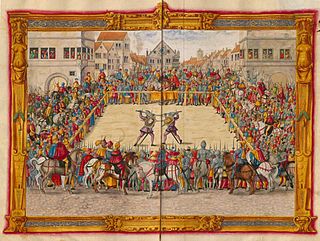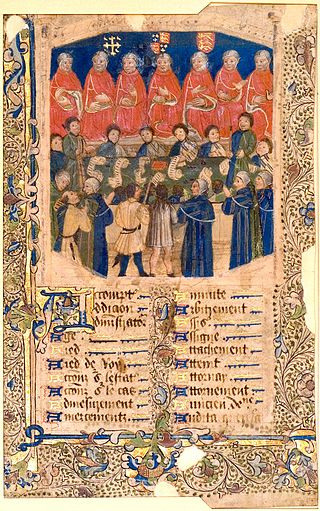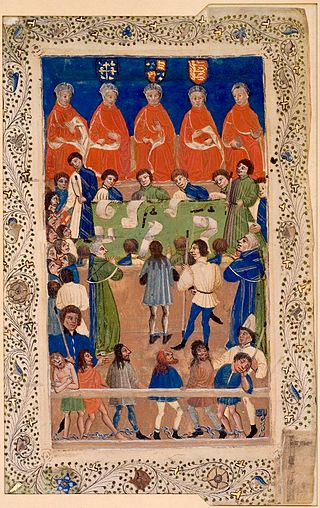Related Research Articles

A jury trial, or trial by jury, is a legal proceeding in which a jury makes a decision or findings of fact. It is distinguished from a bench trial in which a judge or panel of judges makes all decisions.
In English law, the benefit of clergy was originally a provision by which clergymen accused of a crime could claim that they were outside the jurisdiction of the secular courts and be tried instead in an ecclesiastical court under canon law. The ecclesiastical courts were generally seen as being more lenient in their prosecutions and punishments, and many efforts were made by defendants to claim clergy status, often on questionable or fraudulent grounds.
The Assize of Clarendon was an act of Henry II of England in 1166 that began a transformation of English law and led to trial by jury in common law countries worldwide, and that established assize courts.
A legal fiction is a fact assumed or created by courts, which is then used in order to help reach a decision or to apply a legal rule. The concept is used almost exclusively in common law jurisdictions, particularly in England and Wales.

Trial by combat was a method of Germanic law to settle accusations in the absence of witnesses or a confession in which two parties in dispute fought in single combat; the winner of the fight was proclaimed to be right. In essence, it was a judicially sanctioned duel. It remained in use throughout the European Middle Ages, gradually disappearing in the course of the 16th century.

Trial by ordeal was an ancient judicial practice by which the guilt or innocence of the accused was determined by subjecting them to a painful, or at least an unpleasant, usually dangerous experience. In medieval Europe, like trial by combat, trial by ordeal, such as cruentation, was sometimes considered a "judgement of God" : a procedure based on the premise that God would help the innocent by performing a miracle on their behalf. The practice has much earlier roots, attested to as far back as the Code of Hammurabi and the Code of Ur-Nammu.
A quasi-contract is a fictional contract recognised by a court. The notion of a quasi-contract can be traced to Roman law and is still a concept used in some modern legal systems. Quasi contract laws have been deduced from the Latin statement "Nemo debet locupletari ex aliena jactura", which proclaims that no man should grow rich out of another person's loss. It was one of the central doctrines of Roman law.
The forms of action were the different procedures by which a legal claim could be made during much of the history of the English common law. Depending on the court, a plaintiff would purchase a writ in Chancery which would set in motion a series of events eventually leading to a trial in one of the medieval common law courts. Each writ entailed a different set of procedures and remedies which together amounted to the "form of action".

Anglo-Saxon law is a body of written rules and customs that were in place during the Anglo-Saxon period in England, before the Norman conquest. This body of law, along with early Medieval Scandinavian law and Germanic law, descended from a family of ancient Germanic custom and legal thought. However, Anglo-Saxon law codes are distinct from other early Germanic legal statements—known as the leges barbarorum, in part because they were written in Old English instead of in Latin. The laws of the Anglo-Saxons were the second in medieval Western Europe after those of the Irish to be expressed in a language other than Latin.
Assumpsit, or more fully, action in assumpsit, was a form of action at common law used to enforce what are now called obligations arising in tort and contract; and in some common law jurisdictions, unjust enrichment. The origins of the action can be traced to the 14th century, when litigants seeking justice in the royal courts turned from the writs of covenant and debt to the trespass on the case.
The history of Roman law can be divided into three systems of procedure: that of legis actiones, the formulary system, and cognitio extra ordinem. Though the periods in which these systems were in use overlapped one another and did not have definitive breaks, the legis actio system prevailed from the time of the XII Tables until about the end of the 2nd century BC, the formulary procedure was primarily used from the last century of the Republic until the end of the classical period, and cognitio extra ordinem was in use in post-classical times.
Audita querela is a writ, stemming from English common law, that serves to permit a defendant who has had a judgment rendered against him or her to seek relief of the consequences of such a judgment where there is some new evidence or legal defense that was not previously available. The writ is thus generally used to prevent a judgment from being executed where enforcement of that judgment would be "contrary to justice". At common law, the writ may be useful where a creditor engages in fraud before the judgment is rendered, or because the debt had been discharged, paid or otherwise satisfied after the judgment is rendered.
In the Roman litigation system, while the Legis Actiones procedure was in force during the early Republic, both parties had to lay down a wager at the preliminary hearing, probably to discourage frivolous litigation. In some cases, if the party lost, the wager went to the other party, to compensate him for his inconvenience, rather than to the court to cover costs. There were three different types of legis actiones, and the wager differed in each one.

The Court of Common Pleas, or Common Bench, was a common law court in the English legal system that covered "common pleas"; actions between subject and subject, which did not concern the king. Created in the late 12th to early 13th century after splitting from the Exchequer of Pleas, the Common Pleas served as one of the central English courts for around 600 years. Authorised by Magna Carta to sit in a fixed location, the Common Pleas sat in Westminster Hall for its entire existence, joined by the Exchequer of Pleas and Court of King's Bench.

In the legal jurisdiction of England and Wales, there is a long tradition of jury trial that has evolved over centuries. Under present-day practice, juries are generally summoned for criminal trials in the Crown Court where the offence is an indictable offence or an offence triable either way. All common law civil cases were tried by jury until the introduction of juryless trials in the new county courts in 1846, and thereafter the use of juries in civil cases steadily declined. Liability to be called upon for jury service is covered by the Juries Act 1974.

The Bill of Middlesex was a legal fiction used by the Court of King's Bench to gain jurisdiction over cases traditionally in the remit of the Court of Common Pleas. Hinging on the King's Bench's remaining criminal jurisdiction over the county of Middlesex, the Bill allowed it to take cases traditionally in the remit of other common law courts by claiming that the defendant had committed trespass in Middlesex. Once the defendant was in custody, the trespass complaint would be quietly dropped and other complaints would be substituted.

The Court of King's Bench, formally known as The Court of the King Before the King Himself, was a court of common law in the English legal system. Created in the late 12th to early 13th century from the curia regis, the King's Bench initially followed the monarch on his travels. The King's Bench finally joined the Court of Common Pleas and Exchequer of Pleas in Westminster Hall in 1318, making its last travels in 1421. The King's Bench was merged into the High Court of Justice by the Supreme Court of Judicature Act 1873, after which point the King's Bench was a division within the High Court. The King's Bench was staffed by one Chief Justice and usually three Puisne Justices.
Vyavahāra is an important concept of Hindu law denoting legal procedure. The term is analyzed by Kātyāyana as follows: "Vi means ‘various,’ ava means ‘doubt,’ hara is ‘removal’; legal procedure is called by the term vyavahāra because ‘it removes various doubts.’” Kane defines it as follows: "When the ramifications of right conduct, that are together called dharma and that can be established with efforts have been violated, the dispute which springs from what is sought to be proved, is said to be vyavahāra." According to Donald Davis, “There are two basic meanings of vyavahāra. The first is a general sense of practice, business, or everyday transactions. The other, specific sense is legal procedure, the processes of litigation including a trial.” Legal procedure according to the dharmaśāstras includes: court, listening to and assessing witnesses and their testimony, deciding and enforcing punishment, and the pursuit of Justice in the face of Injustice. Davis later quotes the Nāradasmṛti in an attempt to answer the question why legal procedure came about in the Hindu tradition. The text states, “When men had dharma as their only focus and were speakers of the truth, there was no legal procedure, no enmity, and no (selfish) conflict. Legal procedure came into being when dharma was lost among men."

Slade's Case was a case in English contract law that ran from 1596 to 1602. Under the medieval common law, claims seeking the repayment of a debt or other matters could only be pursued through a writ of debt in the Court of Common Pleas, a problematic and archaic process. By 1558 the lawyers had succeeded in creating another method, enforced by the Court of King's Bench, through the action of assumpsit, which was technically for deceit. The legal fiction used was that by failing to pay after promising to do so, a defendant had committed deceit, and was liable to the plaintiff. The conservative Common Pleas, through the appellate court the Court of Exchequer Chamber, began to overrule decisions made by the King's Bench on assumpsit, causing friction between the courts.

The Criminal Law Act 1827 was an Act of the Parliament of the United Kingdom, applicable only to England and Wales. It abolished many obsolete procedural devices in English criminal law, particularly the benefit of clergy. It was repealed by the Criminal Law Act 1967.
References
- ↑ Friedman, Lawrence Meir (1975), The Legal System: A Social Science Perspective, Russell Sage Foundation, p. 272
- 1 2 Common Law Practice Act 1867 (PDF), Office of the Queensland Parliamentary Counsel, 24 June 1994,
Wager of law abolished – 3. No wager of law shall be allowed.
- ↑ English etymology of compurgation, myEtymology.com, retrieved 7 February 2012
- ↑ Delbridge, A; et al., eds. (1997), Macquarie Australia's National Dictionary, The Macquarie Library Pty, p. 388
- 1 2 3 4 Chisholm, Hugh, ed. (1911), , Encyclopædia Britannica , vol. 28 (11th ed.), Cambridge University Press, p. 229
- 1 2 Lehman, Jeffrey; Phelps, Shirelle (2005). West's Encyclopedia of American Law, Vol. 10 (2 ed.). Detroit: Thomson/Gale. p. 113. ISBN 9780787663742.
- 1 2 Hamowy, Ronald (Fall 2003), "F. A. Hayek and the Common Law" (PDF), Cato Journal, Cato Institute, 23 (2), archived from the original (PDF) on 27 January 2012, retrieved 19 February 2012
- ↑ Featured Document: The Magna Carta, Archives.gov, retrieved 19 February 2012
- ↑ compurgation, Encyclopædia Britannica, Inc., retrieved 19 February 2012
- ↑ Fisher, H. A. L., "The Laws of Wales", The Collected Papers of Frederic William Maitland, retrieved 27 January 2006
- ↑
 This article incorporates text from a publication now in the public domain : Chambers, Ephraim, ed. (1728). "Assath, or assach". Cyclopædia, or an Universal Dictionary of Arts and Sciences . Vol. 1 (1st ed.). James and John Knapton, et al. p. 223.
This article incorporates text from a publication now in the public domain : Chambers, Ephraim, ed. (1728). "Assath, or assach". Cyclopædia, or an Universal Dictionary of Arts and Sciences . Vol. 1 (1st ed.). James and John Knapton, et al. p. 223. - ↑ Chester Chronicle, 5 June 1829.
- ↑ Hallaq, Wael (2005). The Origins and Evolution of Islamic Law (7th ed.). UK: Cambridge University Press. p. 25. ISBN 978-0-521-00580-7.